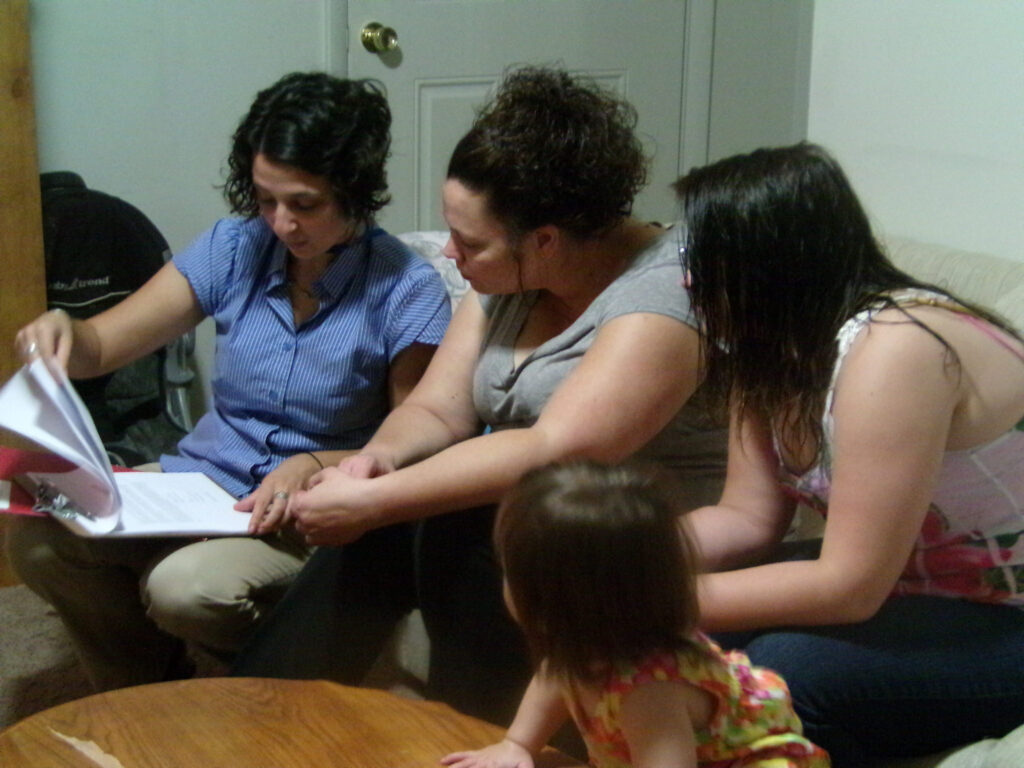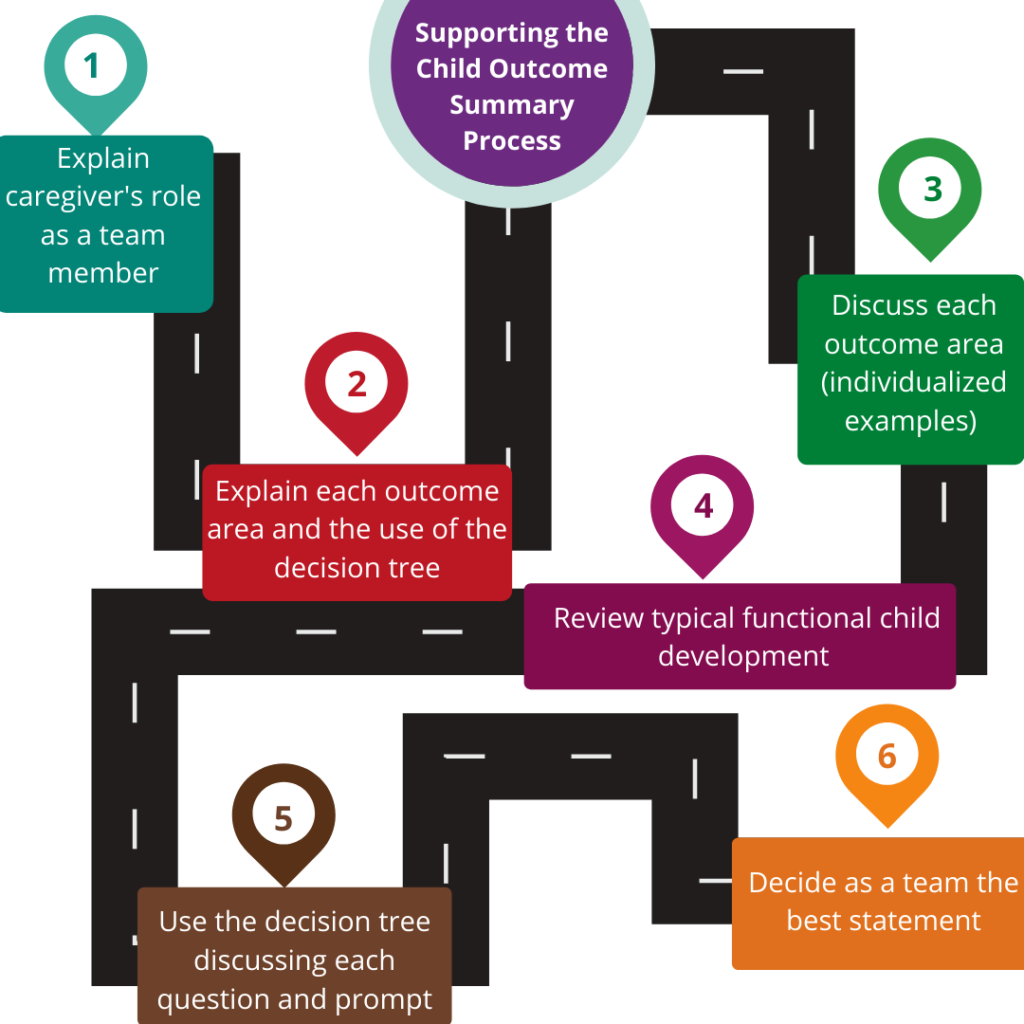
Despite not being able to meet in person, tele-intervention (telehealth) has brought new opportunities to think about how we are talking about the child outcome summary process. Let’s be completely honest. Tele-intervention forces us to use good teaming practices because there cannot be any side conversations among professionals and everyone is only able to see and hear the same information. This helps us think outside of the box to ensure that all team members have the exact same information so caregivers can make the best decisions for their child.
After completing tele-assessments, I have experienced great success incorporating the caregivers in the Child Outcomes Summary (COS) discussion. The COS process summarizes a child’s functional development in three child outcome areas: positive social-emotional skills (including social relationships), acquire and use knowledge and skills (including early language/communication), and use of appropriate behaviors to meet their needs. The Decision Tree can be a helpful tool to facilitate the COS process.
All caregivers participate in the COS discussion using the Decision Tree. This includes deciding with the team which rating statement represents their child’s functioning compared to other kids of the same age. (Click here for more information about the Decision Tree and Virginia’s COS Process). Before even going through the process, it is most helpful to discuss who will facilitate the discussion with the caregiver and the rest of the team members. This includes sharing the screen to show the Decision Tree. This can be the service coordinator or a provider. Here are 6 steps you can use throughout the process that I have found beneficial.

6 Steps for Engaging Caregivers during the COS Process
- Explain the caregiver’s role as a team member.
This is an important step. Caregivers need to understand their role in the process and how they can participate. When they are unsure of what to do, they may be more reluctant to participate. Encourage their voices by involving them throughout process, giving thorough explanations, and asking open-ended questions to receive more in-depth answers.
2. Explain each outcome area and the use of the Decision Tree.
The second page of the Decision Tree shows the Infant & Toddler Connection of Virginia Child Outcomes Summary handout. This handout was specifically designed to support the caregiver’s understanding of the process. It is helpful to send this handout to caregivers prior to the meeting and share the screen with the document pulled up while discussing and highlighting different outcome areas. This will also encourage caregivers’ participation when they fully understand what is being discussed and why.
3. Discuss each outcome area with individualized examples.
During the Assessment for Service Planning, the team discusses functional development within each outcome area based on parent report, observation, clinical opinion, etc. Functional child development focuses on what matters in the family’s daily life, showing how the child is engaging, initiating, and participating throughout their day. It has little meaning to a caregiver if a child can stack blocks, so a functional example would be, “During bath time, Sydney enjoys lining her plastic blocks on the bathtub ledge before knocking them off and laughing. Her mother commented Sydney enjoys playing this game the entire time.” Embedding functional information like this contributes rich examples to the Decision Tree discussion that help all team members understand the child’s abilities and needs. During the discussion, it is also helpful to share the screen to show each outcome area on the IFSP as it is discussed. Screen sharing gives the parent the opportunity to follow along.
4. Review typical functional development.
This is an important step and not to be missed. It truly helps each team member, including the caregiver, understand what is typical for the child’s age within that given child outcome area. This will help each team member understand whether or not the child has “age-expected” functional skills. Utilize your resources for typical development. This can include a combination of resources such as the Act Early Milestones, Functional Development, Age-Expected Snapshots of Development, etc. Again, sharing the screen to show this information and/or sending the info prior to the meeting is beneficial to all team members.
5. Use the Decision Tree discussing each question and prompt.
Again, sharing the screen and/or sending the Decision Tree to the family prior to the meeting can be really helpful. Screen sharing allows each team member (including the caregivers) to look at the same information and follow along accordingly. Ask each question out loud for each decision point. Pause for discussion or examples. When choosing between two items at the decision point, read it and reflect with the caregiver and other team members about specific examples to reach an agreement on the best possible choice. By this point, caregivers should feel empowered to help make the best decision based on the information given to them and understand the importance of their voice.
6. Decide as a team the best statement.
Everyone has a voice. Check in with each person to make sure everyone is in agreement including the caregiver. Discuss specific examples if there is a difference of opinion at any given point in time.
Please note: When I share my screen, I already have these resources pulled up and ready to share as they are discussed: Decision Tree and the Infant & Toddler Connection of Virginia Child Outcomes Summary handout, the child’s IFSP, and information about typical functional development (See #4 above).
What are your top tips to engage families during the Child Outcome Summary Process?
How do you help facilitate the discussion?
Share your tips and ideas by leaving a comment below!
For more information about the COS process and the Decision Tree, check out these resources:
Virginia’s Child Outcomes Booklet: Team Engagement in the Child Outcomes Summary Process
The Decision Tree: A Tool for Teaming and Family Engagement – Parts I and II
ECTA COS Completion: When Teams Can’t Meet in Person
Extra! Extra! Read All About….Integrating the Decision Tree
Logan is Not a Number! – Explaining the Child Outcomes Process


